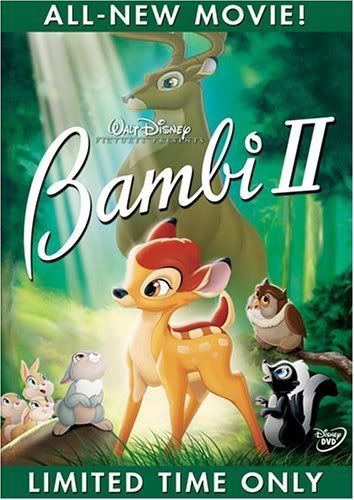Sequelitis
 Before I start the main post, WU would like to wish everyone a happy vernal equinox. Go forth and clean out those closets!
Before I start the main post, WU would like to wish everyone a happy vernal equinox. Go forth and clean out those closets!Disney has made a cottage industry of direct-to-video sequels of their famous classic films. As a parent, my DVD library is replete with Lion King II, Lady and the Tramp II, Little Mermaid II, Cinderella II…you get the picture. This year, Disney has finally come up with a sequel for their classic Bambi, called, yep, Bambi II. As far as their direct-to-video efforts go, it’s pretty decent and offers fiction writers some lessons on how to approach crafting sequels of their own work. Let’s examine how.
Bambi II’s storytelling chronology is a notable departure from Disney’s other attempts (I make exception to the hilarous Lion King 2 ½, a homage to Shakespere’s Guildenstern and Morganstein). Rather than pick up the story in chronological fashion after Bambi becomes the Great Prince of the Forest (what is it with Disney and animal royalty?), the sequel starts at that terrible moment right after Bambi’s mother is killed, and his father finds him alone in the woods. It follows Bambi through that fateful winter. This was a GREAT CHOICE on the part of the filmmakers. The emotional loadstone of the story is in Bambi’s moment of loss. The viewer is invested in caring about how the helpless fawn is going to go on without his mother.
If the filmmakers had selected a chronological approach, they probably would have had to waste time building the character of a new protagonist (Bambi and Faline’s son or daughter). By choosing a moment within the framework of the original story, they were able to focus on the already-developed character of Bambi, and amplify the conflicts he will face in adolescence and in the denouement of Bambi I.
Felix Salten, the author of the 1930's story Bambi, essentially takes the man-against-nature plot and flips it. In Bambi II, the filmmakers wisely amplify the themes of the original story while exploring plot strands only suggested at in the original: Bambi’s relationship with his father; Bambi coming to terms with his mother’s death; and finally, Bambi settling scores with his enemy, the hunter (via his vicious dogs), and in the process, proving himself worthy to succeed the Great Prince of the Forest.
When contemplating a sequel to your next work of fiction, consider a non-chronological approach. Sometimes the story lies hidden within the original.

 posted by Kathleen Bolton at
posted by Kathleen Bolton at 


0 Comments:
Post a Comment
<< Home